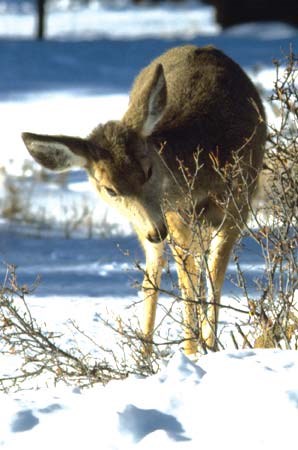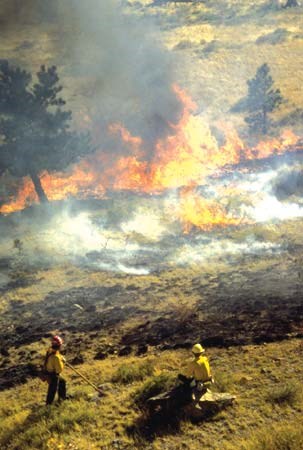Last updated: November 8, 2022
Article
Effects of Browsing and Fire on Shrublands

The Question: What are the combined effects of ungulate browsing and prescribed
fire on montane shrubland communities?
Montane shrublands, dominated by bitterbrush, sagebrush, and wax currant, are an important component of Rocky Mountain National Park because they provide food and shelter for several bird and small mammal species. Elk and deer also intensively browse these shrub communities. The Estes Valley elk population has grown to a historically high level of approximately 3,000 individuals. The Valley’s deer population is estimated to be 600 animals. In recent years, prescribed fire has been used along the Colorado Front Range to restore natural fire regimes and to reduce fuels in lower montane ecoystems including ponderosa pine savannah and associated shrub communities. Shrublands are often found at the wildland-urban interface (WUI), an area of special concern to fire managers due to the risk of a wildland fire moving into adjacent towns. Park decision-makers wanted to understand the effects of intensive browsing by ungulates combined with fire on shrubland communities.
The Project: Continue data collection from four experimental plots in montane shrub communities.
In 1995 researchers set up four experimental sites in upland bitterbrush communities in the park. Fenced plots (no browsing) and unfenced plots (browsed) were established on each site and prescribed burns conducted on half of each fenced and unfenced plot. The result was four treatments at each site: browsed/burned, browsed/unburned, not browsed/burned, and not browsed/unburned. In 1997, a previous team of researchers collected and analyzed data from before the installation of fences, before the burns, and one and two years after the burns. In 2001 and 2002, Dr. Charles Olmstead and Kelly Nesvacil from the University of Northern Colorado continued the project by collecting more post-burn data and assessing the frequency of use of these areas by deer and elk. They analyzed all the information compiled between 1995 and 2002 to see the vegetation results seven years after researchers established the experimental plots.
The Results: A combination of high levels of ungulate browsing and fire results in a decline in the value of montane shrub communities for non-ungulate wildlife.
Seven years after the prescribed burns, the browsed plots had substantially lower biomass than the unbrowsed areas, and researchers concluded the dominant effect on shrubs was due to browsing. Areas that were both browsed and burned had the lowest total values while the unbrowsed/unburned areas had grown so much that canopy area and volume exceeded 1995 values. These data suggest that intense ungulate herbivory alone is likely damaging the value of the park’s montane shrublands as food, habitat, and cover for other wildlife such as bird species that nest in shrublands. Combining heavy browsing with fire results in a further decline of shrub communities.
Based on these project results park managers are not currently using fire as a tool in the park’s montane shrub communities. This decision will be reconsidered if the number of ungulates browsing is reduced through management of the elk population.
This summary is based on published, peer-reviewed and/or unpublished reports available at the time of writing. It is not intended as a statement of park policy or as a definitive account of research results.
For more information on the park’s research program, see https://www.nps.gov/rlc/continentaldivide/research.htm
Written by: Judy Visty Date: September 2004 Updated: January 2008 Photo credit: NPS-RMNP
